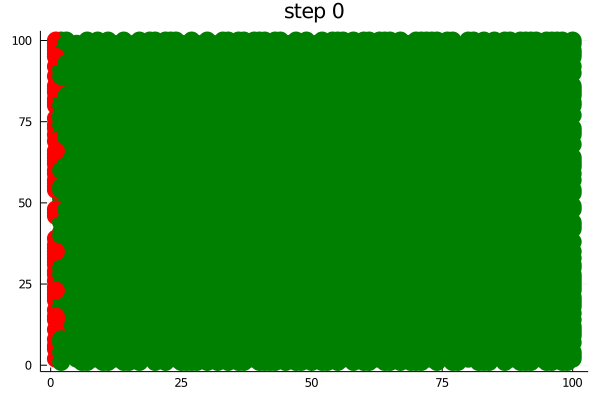Forest fire model

The forest fire model is defined as a cellular automaton on a grid. A position can be empty or occupied by a tree which is ok, burning or burnt. We implement a slightly different ruleset to that of Drossel and Schwabl (1992), so that our implementation can be compared with other ABM frameworks
- A burning position turns into a burnt position
- A tree will burn if at least one neighbor is burning
The forest has an innate density, which is the proportion of trees initialized as green, however all trees that reside at x=1 on the grid are burning. The model is also available from the Models module as Models.forest_fire.
Defining the core structures
We start by defining the agent type
using Agents, Random, Plots
mutable struct Tree <: AbstractAgent
id::Int
pos::Dims{2}
status::Symbol #:green, :burning, :burnt
endThe agent type Tree has three fields: id and pos, which have to be there for any agent, and a status field that we introduce for this specific model. The status field will be :green when the tree is ok, :burning when on fire, and finally :burnt.
We then make a setup function that initializes the model.
function forest_fire(; density = 0.7, griddims = (100, 100))
space = GridSpace(griddims; periodic = false, metric = :euclidean)
forest = AgentBasedModel(Tree, space)
# create and add trees to each position with a probability
# determined by the `density`.
for position in positions(forest)
if rand() < density
# Set the trees at position x=1 on fire
state = position[1] == 1 ? :burning : :green
add_agent!(position, forest, state)
end
end
return forest
end
forest = forest_fire()AgentBasedModel with 7045 agents of type Tree space: GridSpace with size (100, 100), metric=euclidean and periodic=false scheduler: fastest
Defining the step!
Because of the way the forest fire model is defined, we only need a stepping function for the agents
function tree_step!(tree, forest)
# The current tree is burning
if tree.status == :burning
# Find all green neighbors and set them on fire
for neighbor in nearby_agents(tree, forest)
if neighbor.status == :green
neighbor.status = :burning
end
end
tree.status = :burnt
end
endRunning the model
step!(forest, tree_step!, 1)
count(t->t.status == :burnt, allagents(forest))125
step!(forest, tree_step!, 10)
count(t->t.status == :burnt, allagents(forest))1328
Now we can do some data collection as well using an aggregate function percentage:
Random.seed!(2)
forest = forest_fire(griddims = (20, 20))
burnt_percentage(m) = count(t->t.status == :burnt, allagents(m)) / length(positions(m))
mdata = [burnt_percentage]
_, data = run!(forest, tree_step!, 10; mdata)
data| step | burnt_percentage | |
|---|---|---|
| Int64 | Float64 | |
| 1 | 0 | 0.0 |
| 2 | 1 | 0.065 |
| 3 | 2 | 0.14 |
| 4 | 3 | 0.23 |
| 5 | 4 | 0.295 |
| 6 | 5 | 0.35 |
| 7 | 6 | 0.4 |
| 8 | 7 | 0.4475 |
| 9 | 8 | 0.4975 |
| 10 | 9 | 0.56 |
| 11 | 10 | 0.635 |
Now let's plot the model. We use green for unburnt trees, red for burning and a dark red for burnt.
forest = forest_fire()
step!(forest, tree_step!, 1)
function treecolor(a)
color = :green
if a.status == :burning
color = :red
elseif a.status == :burnt
color = :darkred
end
color
end
plotabm(forest; ac = treecolor, ms = 5)or animate it
forest = forest_fire(density = 0.6)
anim = @animate for i in 0:10
i > 0 && step!(forest, tree_step!, 5)
p1 = plotabm(forest; ac = treecolor, ms = 5, msw = 0)
title!(p1, "step $(i)")
end
gif(anim, "forest.gif", fps = 2)